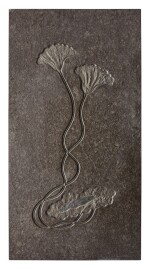History of Science & Technology, Including Fossils, Minerals, & Meteorites
History of Science & Technology, Including Fossils, Minerals, & Meteorites

A Double Fossil Sea Lily Mural
Lot Closed
April 28, 06:19 PM GMT
Estimate
30,000 - 40,000 USD
Lot Details
Description
A Double Fossil Sea Lily Mural
Seirocrinus subangularis
Lower Jurassic
Lias Epsilon II 3 Formation, Holzmaden, Southern Germany
Each specimen measuring approx 48 inches tall, in 64 1/2 x 33 1/2 limestone matrix. Crowns measuring 10 x 7 and 10 x 8 inches across respectively. A beautifully intertwined pair, with delicately opened calices, complete with attached fossilized driftwood. The beauty of the present fossil is further enhanced by a layer of pyrite, granting it a slight metallic lustre that glows against the dark background of the natural stone panel.
The Seirocrinus subangularis is scientifically part of the Echinoderm class, which in Greek means "spikey skin." It is a very ancient marine animal group, with its first fossils appearing around the Cambian. There are about 7,000 species living today, with the most famous being the sea urchin; the some 13,000 other species of this class are all extinct.
A number of unique characteristics that appear nowhere else in the animal kingdom give these "Sea Lilies" an surrealistic appearance, most notably its pentaradial symmetry and a water vascular system that maintains hydraulic pressure in the tube feet.
Despite the name, and its flower-like appearance, they were not actually plants, but rather, beautifully colored tentacular invertebrate sea animals. The animal would open its calyx (resembling the petals of a flower), which contain a filter-like organ, permitting it to capture and feed off of sea-plankton. Sea Lilies would often attach themselves to driftwood as part of a colony, or, as in the case of this superb specimen, as a solitary animal drifting freely in the sea — we can even clearly see the mass of wood that this specimen was attached to, fossilized along with its inhabitant.
